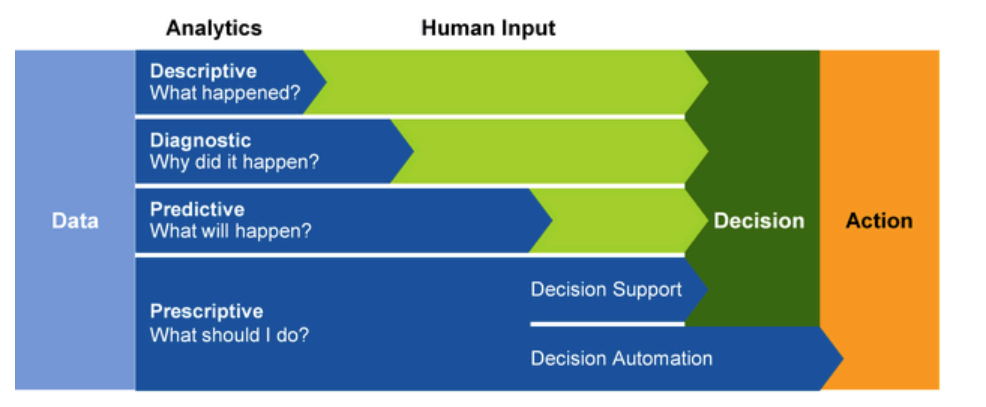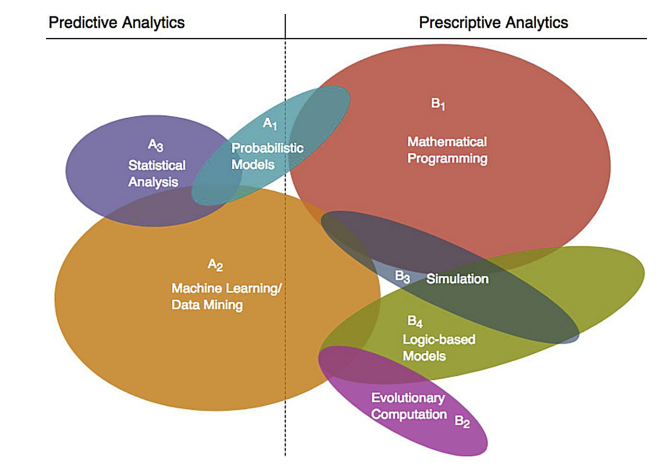The importance of utilizing advanced analytics
Businesses are rapidly evolving in today’s world with the help of data. Data is not just a resource, but it is the lifeline of numerous modern organizations. The ability to harness the power of advanced analytics is no longer a luxury but it is a strategic imperative. The ability to manage, analyze, and act on data (driven-decision systems) is very important to organizations and is characterized as a significant asset (Vassakis, Petrakis, & Kopanakis, 2018). This article goes in-depth by uncovering the promising future of advanced analytics within organizations.
The four phases of advanced analytics:
This chapter presents the various phases of advanced analytics, depicting the distinct phases in figure 1. Furthermore, it gives an overview of which analytical methods are mostly used between the different phases.
1st phase: Descriptive analytics: The Foundations of advanced analytics
Descriptive analytics is the cornerstone upon which advanced analytics stands. Descriptive analytics is able to detect patterns that indicate a potential root cause, problem, or future opportunities for the organization. Thereby being able to predict whether an event will happen, when it is to happen as well the reason why it will happen by analysing historical data. However, this is limited, since it is much dependent on human decisions, which are limited to their knowledge and experience (Leponioti, Bousdekis, Apostolou, & Mentzas, 2020). Used methods within descriptive analytics are using traditional Business Intelligence (BI) tools, like PowerBI (Gartner, n.d.).
2nd phase: Diagnostic Analytics: The “Why” Behind certain events
Diagnostic analytics which is related to the question “Why did this/something happen?” helps organizations to grasp the reason for the event that happened in the past and understand patterns, correlations, and root causes among different kinds of data (Leponioti, Bousdekis, Apostolou, & Mentzas, 2020). For instance, a retail giant might employ diagnostic analytics to understand why sales slumped in a particular quarter, revealing factors such as shifts in consumer behaviour or market dynamics. Diagnostic analytics not only uncovers what happened but also why it happened, providing organizations with valuable insights into the drivers of their past performance. It allows businesses to identify inefficiencies, bottlenecks, or areas of improvement in their operations. However, diagnostic analytics primarily operates in hindsight, offering limited capabilities for real-time decision-making.
3rd phase: Predictive Analytics: Predicting the future with data
Currently, the vast majority of business analytics efforts are spent on predictive and descriptive analytics with typically used methods like data mining, machine learning, artificial intelligence, and simulations to forecast future outcomes (Leponioti, Bousdekis, Apostolou, & Mentzas, 2020). An example is detecting fraudulent financial transactions by analysing large data sets with the help of machine learning. Predictive analytics can be considered the next step towards increasing data analytics maturity and is leading to optimized decision-making. However predictive analytics is still less mature compared to descriptive analytics (Mousheimish, Taher, & Zeitouni, 2016). Predictive analytics builds on diagnostic insights by looking forward, anticipating future trends, and forecasting the outcomes. It leverages historical data to create models that predict future events or behaviours. Used methods within predictive analytics are regression analysis, forecasting, multivariate statistics, pattern matching and machine learning (ML) (Gartner, n.d.).
4th phase: Prescriptive Analytics: Guiding and Automating Decisions
As we look ahead into the future, prescriptive analytics enables endless possibilities. This phase transcends prediction, offering actionable recommendations and even the automation of decision-making processes. New information and communication technologies (ICT), such as the Internet of Things (IoT), real-time streaming, and sensor-driven operations have supported and provided prescriptive analytics with accurate prescriptions facilitating reliable and effective decision-making (Leponioti, Bousdekis, Apostolou, & Mentzas, 2020). Prescriptive analytics takes a proactive approach by predicting outcomes and recommending the best course of action to achieve the desired results. It answers the crucial question of “What should we do?” and It provides organizations with specific actions to optimize processes. For instance, in finance, prescriptive analytics can recommend investment strategies based on market conditions and risk tolerance. This is called decision support, but prescriptive analytics can also be fully automated. Making the decisions and performing actions independently.

How to utilize predictive and prescriptive analytics:
This chapter presents how to effectively utilize predictive and prescriptive analytics within your organization (Leponioti, Bousdekis, Apostolou, & Mentzas, 2020). Multiple methods used within businesses and research are compiled to give an overview on which methods could be applied to extract new value from the data. See figure 2 for the different methods between predictive and prescriptive analytics.
Most used methods for predictive analytics:
A1) Probabilistic models
Probabilistic models use probability theory to assess uncertainty and make predictions or recommendations based on the likelihood of different outcomes. Probabilistic models in prescriptive analytics help in decision-making by considering various possible scenarios and their associated probabilities, allowing organizations to choose actions that maximize desired outcomes while accounting for uncertainty.
A2) Machine learning/data mining
Machine learning and data mining enable the extraction of valuable patterns and insights from large datasets. Machine learning algorithms, such as random forests, decision trees, and neural networks could be used to construct models that provide recommendations for actions to optimize outcomes. Data mining helps in uncovering hidden relationships and trends within data, which can inform prescriptive analytics solutions.
A3) Statistical analysis
Statistical analysis involves the use of statistical methods to analyse data, identify correlations, assess the significance of variables, and determine the likelihood of specific outcomes. Statistical analysis informs the development of prescriptive models and guides decision-makers in selecting appropriate actions based on data-driven insights.
Most used methods for prescriptive analytics:
B1) Mathematical programming
Linear-programming, integer-programming, and non-linear programming are examples of methods used to formulate and solve optimization problems. These techniques help organizations find the best set of actions or resource allocations to achieve specific objectives while considering constraints and trade-offs.
B2) Evolutionary computation
Evolutionary computation algorithms, such as genetic algorithms and particle swarm optimization, are utilized to find optimal solutions in complex and dynamic environments. The algorithms mimic natural selection and evolution to search for the most favourable actions or strategies. Evolutionary computation is especially useful when dealing with high-dimensional and nonlinear optimization problems.
B3) Simulation
Simulation is a powerful method that involves creating computational models to replicate real-world scenarios. These models can be used to test different decision strategies and their impacts under various conditions. Simulations allow organizations to assess the consequences of different actions before implementation, supporting the decision-makers in making informed choices. For example, they can simulate the effects of server improvements based on incident ticket data.
B4) Logic-based models
Logic-based models use formal logic, rules, and knowledge representation to make decisions and recommendations. These models are valuable in prescriptive analytics for situations where explicit rules and constraints govern decision-making. These models can incorporate expert knowledge and business rules into the decision-making process, ensuring that actions align with organizational objectives and compliance requirements.

The advantages and disadvantages of analytics
The main advantages of using predictive and prescriptive analytics:
In today’s business environment, predictive and prescriptive analytics are crucial methods to gain competitive advantage. These methods improve decision-making, increase productivity, reduce costs, and reduce risk when used correctly. Organizations are able to forecast future trends and outcomes using predictive analytics, which analyses historical data using predictive and prescriptive methods, which were described in the previous chapter. Prescriptive analytics offers actionable recommendations, takes into account numerous variables and constraints, and guides decision-makers toward the best choices and actions. Prescriptive analytics can also be combined with automation where the system automatically executes the tasks. Together, these cutting-edge analytics methods support businesses in resolving difficult issues.
The ethical disadvantages of using prescriptive analytics
As we noted earlier, prescriptive analytics provides the best set of actions to be taken to prevent undesirable outcomes for a given instance. However, this mechanism is prone to risks (Harikumar, et al., 2022). The risks are linked to privacy, inappropriate decision-making, and implementation risk. Privacy risks occur at first with personalized recommendations where the model relies on personalized data which can include sensitive information about individuals. The inappropriate decision-making risk exists because machine learning predictions may sway people to a course of inaction, complacency action, or even when automated inappropriate course of action. The implementation risk exists since these systems require close surveillance and highly qualified analysts/data scientists, which makes it complex and costly to operate (Harikumar, et al., 2022).
While these risks could be harmful to your business, they are manageable through a combination of strategies and best practices. Privacy protection, ethical decision-making, efficient implementation, continuous monitoring, and education all play pivotal roles in mitigating these risks. By implementing these measures (Harikumar, et al., 2022). Organizations can harness the full potential of prescriptive analytics while ensuring responsible and reliable decision-making.
Conclusion:
The future of advanced analytics within organizations is not solely a destination but it is an ongoing journey of transformation and innovation. As we explored the possibilities of descriptive, diagnostic, predictive, and prescriptive analytics, we have uncovered the evolving landscape of data-driven decision-making, which is an unmissable part of steering organizations in the right direction and a worthwhile investment.
Descriptive analytics served as the foundation, allowing organizations to understand what happened in the past. Diagnostic analytics delved deeper, by understanding the “why” behind events, providing valuable insights into the drivers of past performance. Predictive analytics enables organizations to look into the future, forecasting trends and outcomes. Finally, prescriptive analytics emerged as the ultimate guide, not only predicting what will happen but also recommending the best course of action or even performing actions itself.
References:
Gartner. (2014, October). Four Types of Analytics Capability. Retrieved September 2023, from Gartner: https://www.gartner.com/en/newsroom/press-releases/2014-10-21-gartner-says-advanced-analytics-is-a-top-business-priority
Harikumar, H., Rana, S., Gupta, S., Nguyen, T., Kaimal, R., & Venkatesh, S. (2022). Prescriptive analytics with differential privacy. International Journal of Data Science and Analytics, pp. 123-138.
Leponioti, K., Bousdekis, A., Apostolou, D., & Mentzas, G. (2020). Prescriptive analytics: Literature review and research challenges. International Journal of Information Management, pp. 57-70.
Mousheimish, R., Taher, Y., & Zeitouni, K. (2016). autoCEP: Automatic Learning of Predictive Rules for Complex Event Processing. autoCEP: Automatic Learning of Predictive Rules for Complex Event Processing, pp. 586-593.
Vassakis, K., Petrakis, E., & Kopanakis, I. (2018). Big Data Analytics: Applications, Prospects and Challenges. Mobile Big Data, pp. 3-18.




